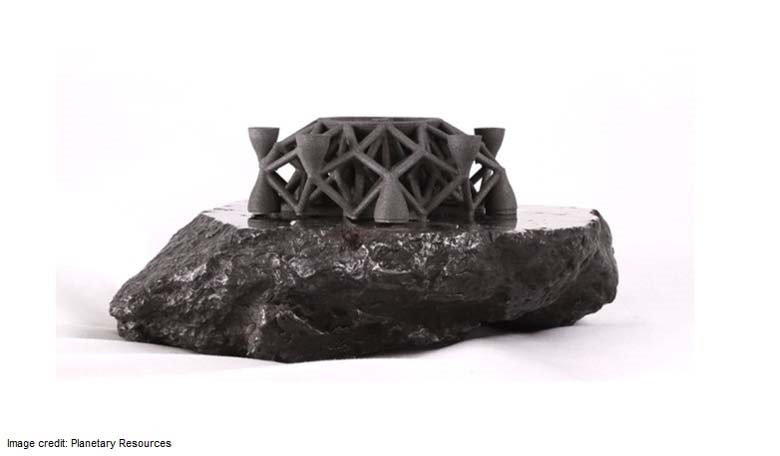Colonising raw materials found in space to perhaps one day provide fuel or homes for future space pioneers has moved one step closer as Planetary Resources, in collaboration with their partner 3D Systems, have developed the first ever direct metal print from asteroid metals.
This prototype, that is the first part ever 3D Printed with material from outer space is reminiscent of a design that could originate from a 3D printer in the zero-gravity environment of space and was created from an actual asteroid that was pulverised, powdered and processed on the new 3D Systems Direct metal 320 printer. “This is going to transform manufacturing and 3D printing aerospace technology and the way that we explore and develop our frontiers in outer space,” said Chris Lewicki, the president and CEO of Planetary Resources, in a recent interview at the Consumer Electronics Show (CES) in Las Vegas, NV.
Planetary resources is an asteroid mining company whose goal is to expand the economy of humanity into space through the use and pursuit of resources. While showcasing the 3D printed prototype made from an asteroid that crash-landed on Earth a few million years ago, Lewicki explained that he envisages future astronauts or space pioneers using materials found in space, such as asteroids, to provide the resources needed to continue space exploration further and further afield from Earth. Lewicki believes that humanity is destined to be a multi-planetary species and in order to achieve this, it is vital that astronauts can utilise natural resources found in space.
Lewicki explains that if we want to get off the planet and make our mark on the wider Galaxy, then settlements or outposts will be needed where raw materials can be harnessed to provide fuel, clothing etc. At present anything sent into space is disregarded once it runs out of fuel, what Planetary Resources is hoping to do, is to create a number of space-based ‘refuelling stations’ as it were, to aid in the continuation of space exploration. Of course a home away from home also safeguards humanity should something terrible happen here on Earth, but Lewicki is quick to point out that Earth is not disposable. Making a home elsewhere in the Universe is simply the next step in expanding our presence beyond our own planet.
The asteroid (or meteorite) used by Planetary Resources and 3D Systems for the print materials was sourced from the Campo Del Cielo impact near Argentina, and is composed of iron, nickel and cobalt – similar materials to refinery grade steel. However, asteroids are also composed of other elements considered rare on Earth, such as platinum and other types of platinum group metals. As asteroids number in the tens of millions in our solar system alone, they represent a potentially unlimited amount of resources in space and it is companies such as Planetary Resources who are developing the tools in which to extract these assets. Nonetheless, Lewicki points out that one of the first substances that will be pursued is water. Apart from being essential for life (as we know it), water is made up of hydrogen and oxygen, two elements that are used in rocket fuel and is hence a major component in propelling astronauts further into the outer reaches of space.
As Lewicki explains, that although this may all sound rather like science-fiction, it is something that is being looked at now by Planetary Resources and it is only a matter of time before we start having a commercialised space industry that thrives not only on this planet, but elsewhere in the Galaxy (and perhaps the Universe). To watch the full interview by Engadget at the Consumer Electronics
Show, click here: www.engadget.com











